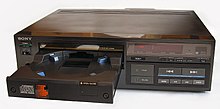Sony CDP-101
The Sony CDP-101 was the first commercially available CD player . Sales began in Japan on October 1, 1982 at a list price of 168,000 yen (about 2300 DM).
The early start in Japan was due to the cooperation with Philips , as both developed the compact disc together . Philips was unable to set a precise start date for sales of its competing CD 100 product. It was agreed that Sony would only release its CDP-101 in Japan before the Philips CD 100. The CD 100 went on sale worldwide from November 1982, and it was not until March 1983 that the CDP-101 was available in stores to fulfill the contractual agreements. The production period of the CDP-101 was from 1982 to 1985.
design
Originally, according to the first draft, the CD should be inserted vertically into the player and be able to see it through a transparent front. Instead, the CDP-101 opted for the tray loading system. The housing and the front panel of the device are made of plastic.
On the front you can see a fluorescent display on which you can see the track number and the playing time and the infrared receiver so that commands can also be received via remote control. The only rotatable control element on the device is the volume control for the headphones. Headphones can be connected under the volume control.
In addition, the device has two switches on the back; one each for the auto-pause and anti-shock functions. In addition, there are two cinch sockets for left and right audio output and a 26-pin plug connector as an accessory connection. There is a heat sink on the back.
The buttons on the associated RM-01 remote control have the same functions as on the main unit; however, there is also a number pad that can be used to select the track numbers directly.
The model name CDP-101 was chosen by Nobuyuki Idei, who was also head of development. 101 represents the number 5 in the binary number system; it was also chosen because the device was to be marketed as a "normal middle-class model".
technology
Due to the cost of manufacturing digital-to-analog converters (DAC) at the time of production, the CDP-101 only has one DAC, which alternates between the left and right audio channels. There is also no sample-and-hold circuit to compensate for the resulting delay, so that the left and right channels are not synchronous, but are delayed by about eleven microseconds .
In contrast to the Philips CD 100, which uses oversampling in order to be able to use the Philips own 14-bit DAC, the CDP-101 uses a real 16-bit DAC, which was developed and manufactured by Sony.
success
Due to the sales success, Sony (like several other companies) produced several CD players such as the CDP 102 and the CDP 195 in the following years.
Individual evidence
- ^ Sony Corporate info home audio. Retrieved August 30, 2014 .
- ↑ Home Audio Product & Technology Milestones Sony.net
- ^ Sony History: A Great Invention 100 Years On Archive.org
- ↑ Shannon, Beethoven, and the Compact Disc by Kees A. Schouhamer Immink exp-math.uni-essen.de ( Memento of the original from November 4, 2014 in the Internet Archive ) Info: The archive link was inserted automatically and has not yet been checked. Please check the original and archive link according to the instructions and then remove this notice.
- ↑ Kretschmer, Tobias and Muehlfeld, Katrin, Co-opetition in Standard-Setting: The Case of the Compact Disc (October 2004). NET Institute Working Paper No. 04-14. ssrn.com
- ↑ Sony CDP-101 back of the CDP 101
- ↑ Sony History: A Great Invention 100 Years On Marketing
- ↑ Sony CDP-101 CD Player Adrian-kingston.com
